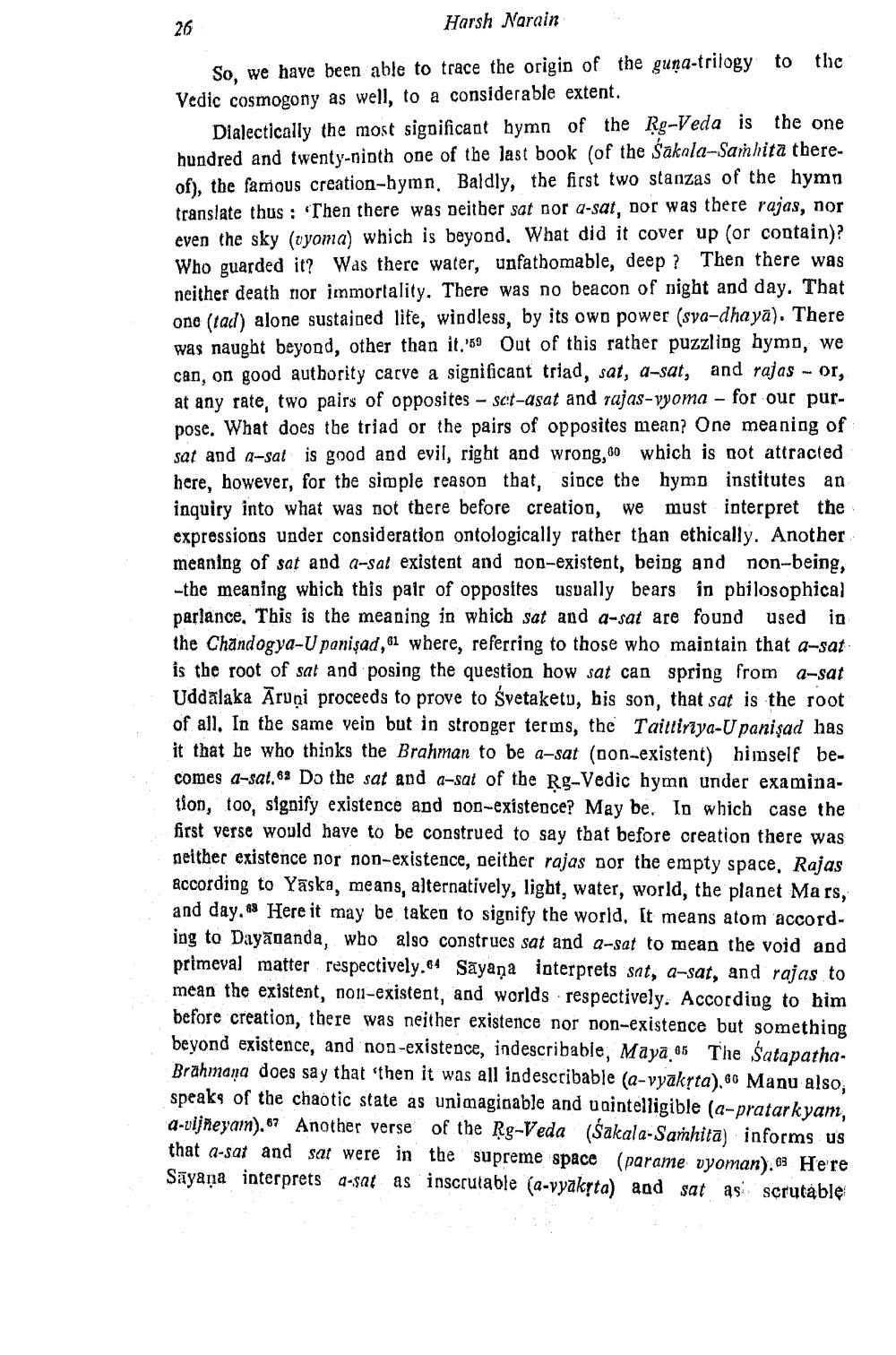________________
26
Harsh Narain
to the So, we have been able to trace the origin of the guna-trilogy Vedic cosmogony as well, to a considerable extent.
Dialectically the most significant hymn of the Rg-Veda is the one hundred and twenty-nipth one of the last book (of the Sakola-Samhita thereof), the famous creation-hymn. Baldly, the first two stanzas of the hymn translate thus : Then there was neither sat nor 2-sat, nor was there rajas, nor even the sky (uyoma) which is beyond. What did it cover up (or contain)? Who guarded it? Was there water, unfathomable, deep? Then there was neither death nor immortality. There was no beacon of night and day. That one (tad) alone sustained life, windless, by its own power (sya-dhayā). There was naught beyond, other than it,'59 Out of this rather puzzling hymn, we can, on good authority carve a significant triad, sat, a-sat, and rajas - or, at any rate, two pairs of opposites - sct-asat and rajas-vyoma - for our purpose. What does the triad or the pairs of opposites mean? One meaning of sat and a-sat is good and evil, right and wrong,60 which is not attracted here, however, for the simple reason that, since the hymo institutes an inquiry into what was not there before creation, we must interpret the expressions under consideration ontologically rather than ethically. Another meaning of sat and a-sal existent and non-existent, being and non-being, -the meaning which this pair of opposites usually bears in pbilosophical parlance. This is the meaning in which sat and a-sat are found used in the Chandogya-U panişad, 61 where, referring to those who maintain that a-sat is the root of sat and posing the question how sat can spring from a-sat Uddalaka Āruni proceeds to prove to Svetaketu, his son, that sat is the root of all, In the same vein but in stronger terms, the Tailtiniya-U panişad has it that he who thinks the Brahman to be a-sat (non-existent) himself becomes a-sat.62 Do the sat and a-sat of the Rg-Vedic hymn under examination, too, signify existence and pon-existence? May be. In which case the first verse would have to be construed to say that before creation there was neither existence nor non-existence, neither rajas por the empty space, Rajas According to Yaska, means, alternatively, light, water, world, the planet Mars, and day, 48 Here it may be taken to signify the world. It means atom according to Dayananda, who also construes sat and a-sat to mean the void and primeval matter respectively.64 Sāyaṇa interprets sat, a-sat, and rajas to mean the existent, non-existent, and worlds respectively. According to him before creation, there was neither existence nor non-existence but something beyond existence, and non-existence, indescribable, Maya 65 The Satapatha. Brahmana does say that 'then it was all indescribable (a-vyaksta).66 Manu also, speaks of the chaotic state as unimaginable and usintelligible (a-pratarkyam, a-vijñeyam).67 Another verse of the Rg-Veda (Šakala-Samhita) informs us that a-sat and sat were in the supreme space (parame vyoman). Here Sayana interprets a-sat as inscrutable (a-vyakyta) and sat as scrutable




